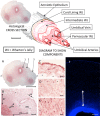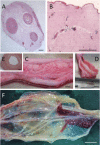Concise Review: Wharton's Jelly: The Rich, but Enigmatic, Source of Mesenchymal Stromal Cells
- PMID: 28488282
- PMCID: PMC5689772
- DOI: 10.1002/sctm.16-0492
Concise Review: Wharton's Jelly: The Rich, but Enigmatic, Source of Mesenchymal Stromal Cells
Abstract
The umbilical cord has become an increasingly used source of mesenchymal stromal cells for preclinical and, more recently, clinical studies. Despite the increased activity, several aspects of this cell population have been under-appreciated. Key issues are that consensus on the anatomical structures within the cord is lacking, and potentially different populations are identified as arising from a single source. To help address these points, we propose a histologically based nomenclature for cord structures and provide an analysis of their developmental origins and composition. Methods of cell isolation from Wharton's jelly are discussed and the immunophenotypic and clonal characteristics of the cells are evaluated. The perivascular origin of the cells is also addressed. Finally, clinical trials with umbilical cord cells are briefly reviewed. Interpreting the outcomes of the many clinical studies that have been undertaken with mesenchymal stromal cells from different tissue sources has been challenging, for many reasons. It is, therefore, particularly important that as umbilical cord cells are increasingly deployed therapeutically, we strive to better understand the derivation and functional characteristics of the cells from this important tissue source. Stem Cells Translational Medicine 2017;6:1620-1630.
Keywords: Embryology; Mesenchymal stromal cell; Therapy; Wharton's Jelly.
© 2017 The Authors Stem Cells Translational Medicine published by Wiley Periodicals, Inc. on behalf of AlphaMed Press.
Figures





Similar articles
-
Comparison of Different Culture Conditions for Mesenchymal Stem Cells from Human Umbilical Cord Wharton’s Jelly for Stem Cell Therapy.Turk J Haematol. 2020 Feb 20;37(1):67-69. doi: 10.4274/tjh.galenos.2019.2019.0439. Epub 2019 Nov 13. Turk J Haematol. 2020. PMID: 31718116 Free PMC article. No abstract available.
-
Wharton's Jelly stem cells: future clinical applications.Placenta. 2011 Oct;32 Suppl 4:S311-5. doi: 10.1016/j.placenta.2011.06.010. Epub 2011 Jul 6. Placenta. 2011. PMID: 21733573 Review.
-
Characteristics of mesenchymal stem cells derived from Wharton's jelly of human umbilical cord and for fabrication of non-scaffold tissue-engineered cartilage.J Biosci Bioeng. 2014 Feb;117(2):229-235. doi: 10.1016/j.jbiosc.2013.07.001. Epub 2013 Jul 27. J Biosci Bioeng. 2014. PMID: 23899897
-
Isolation of Wharton's Jelly-Derived Mesenchymal Stromal/Stem Cells.Methods Mol Biol. 2025;2938:21-29. doi: 10.1007/978-1-0716-4607-6_3. Methods Mol Biol. 2025. PMID: 40445276
-
Perspectives of employing mesenchymal stem cells from the Wharton's jelly of the umbilical cord for peripheral nerve repair.Int Rev Neurobiol. 2013;108:79-120. doi: 10.1016/B978-0-12-410499-0.00004-6. Int Rev Neurobiol. 2013. PMID: 24083432 Review.
Cited by
-
Human umbilical cord mesenchymal stem cells in type 2 diabetes mellitus: the emerging therapeutic approach.Cell Tissue Res. 2021 Sep;385(3):497-518. doi: 10.1007/s00441-021-03461-4. Epub 2021 May 29. Cell Tissue Res. 2021. PMID: 34050823 Review.
-
Preclinical Studies and Clinical Prospects of Wharton's Jelly-Derived MSC for Treatment of Acute Radiation Syndrome.Curr Stem Cell Rep. 2021;7(2):85-94. doi: 10.1007/s40778-021-00188-4. Epub 2021 Apr 28. Curr Stem Cell Rep. 2021. PMID: 33936933 Free PMC article. Review.
-
Manufacturing of primed mesenchymal stromal cells for therapy.Nat Biomed Eng. 2019 Feb;3(2):90-104. doi: 10.1038/s41551-018-0325-8. Epub 2019 Jan 28. Nat Biomed Eng. 2019. PMID: 30944433 Review.
-
Mesenchymal stromal cells and their derivatives - putative therapeutics in the management of autoimmune pancreatitis.FEBS Open Bio. 2020 Jun;10(6):969-978. doi: 10.1002/2211-5463.12866. Epub 2020 May 13. FEBS Open Bio. 2020. PMID: 32323467 Free PMC article. Review.
-
Physiologically-Modeled Dynamic Stimulation and Growth Factors Induce Differentiation of Mesenchymal Stem Cells to a Vascular Endothelial Cell Phenotype.Microcirculation. 2025 Apr;32(3):e70007. doi: 10.1111/micc.70007. Microcirculation. 2025. PMID: 40120632
References
-
- Joerger‐Messerli MS, Marx C, Oppliger B et al. Mesenchymal stem cells from Wharton's jelly and amniotic fluid. Best Pract Res Clin Obstet Gynaecol 2016;31:30–44. - PubMed
-
- Ding D‐C, Chang Y‐H, Shyu W‐C et al. Human umbilical cord mesenchymal stem cells: A new era for stem cell therapy. Cell Transplant 2015;24:339–47. - PubMed
-
- El Omar R, Beroud J, Stoltz J‐F et al. Umbilical cord mesenchymal stem cells: The new gold standard for mesenchymal stem cell‐based therapies? Tissue Eng Part B Rev 2014;20:523–544. - PubMed
Publication types
MeSH terms
LinkOut - more resources
Full Text Sources
Other Literature Sources

